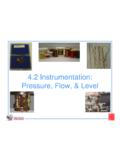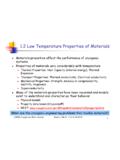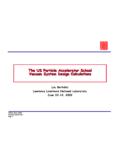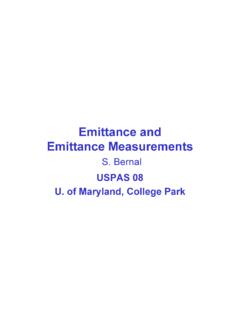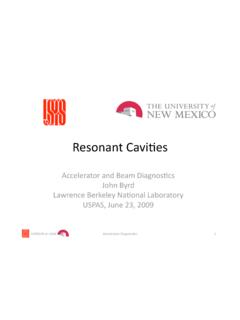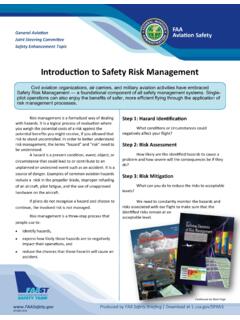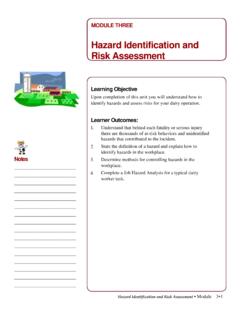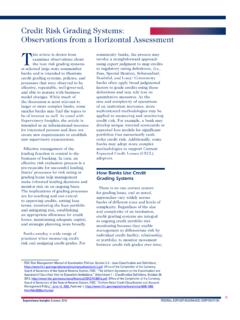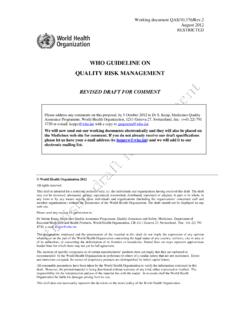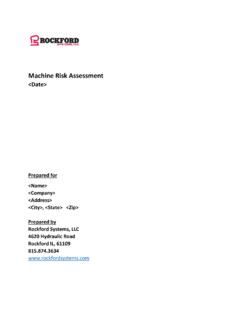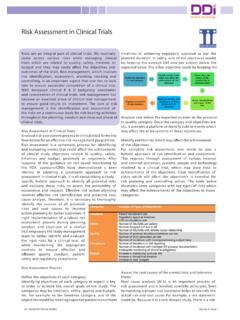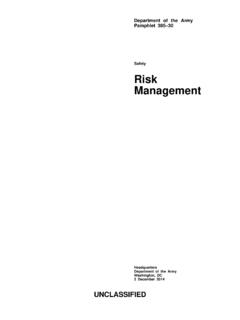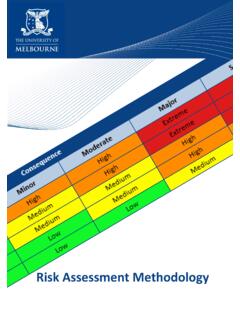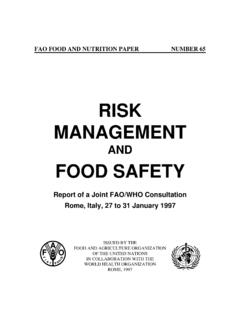Transcription of Hazard Assessment and Risk Analysis - Fermilab
1 Controlling risks Hazard Assessment and Risk Analysis Analysis Phase Managementof functionalSafety and Safety assessmentSafetyLifecycleStructureandPla nningRisk Analysis and protection layer designAllocation of safety functions to safety instrumented systems or other means of risk reductionSafety requirements specification for the SISD esign and development ofSafety Instrumented SystemDesign and development ofOther means of risk reductionInstallation, commissioning, and validationOperation and maintenanceModificationDecommissioningVe rificationUSPAS January 2012 Controlling risks : Safety Systems Most encountered words from senior management? I do not want any surprises Hazard and risk Analysis are a means to that USPAS January 2012 Controlling risks : Safety Systems Hazard Analysis Hazard Analysis uncovers and identifies hazards that exist in the workplace, generally focusing on a particular activity, project, or system. Basic information for risk based decisions Develop a means to: Communicate Track Quantify Allocate mitigation measures Verify effectiveness Hazard Analysis can also be referred to as Hazard recognition, based upon the above definition.
2 USPAS January 2012 Controlling risks : Safety Systems Standards - IEC61508 (part ) determine the hazards and hazardous events of the EUC and the EUC control system (in all modes of operation) for all reasonably foreseeable circumstances, including fault conditions and misuse. determine the event sequences leading to the hazardous events determined by the Analysis . determine the EUC risks associated with the hazardous events determined by the Analysis . *EUC= Equipment Under Control USPAS January 2012 Controlling risks : Safety Systems Anticipate Hazard Assessment of a proposed facility or system should occur before design criteria or other, less formal work-description documents are drafted, ideally even before initial concepts are finalized. USPAS January 2012 Controlling risks : Safety Systems Definitions Hazard a state or set of conditions of a system (or an object) that, together with other conditions in the environment of the system (or object), will lead inevitably to an accident (loss event).
3 Hazard Level the combination of severity and likelihood of occurrence USPAS January 2012 Controlling risks : Safety Systems Definitions - continued Accident an undesired and unplanned (but not necessarily unexpected) event that results in (at least) a specified level of loss. Mishap Department of Defense term for accident which is defined as an unwanted or uncontrolled release of energy or a toxic exposure. Near miss/incident an event that involves no loss (or only minor loss) but with the potential for loss under different circumstances. USPAS January 2012 Controlling risks : Safety Systems Definitions - continued Safety freedom from accidents or losses Reliability the probability that a piece of equipment or component will perform its intended function satisfactorily for a prescribed time under stipulated environmental conditions. Error a design flaw or deviation from a desired or intended state. USPAS January 2012 Controlling risks : Safety Systems Definitions - continued Severity of occurrence the worst possible accident that could result from the Hazard given the environment in its most unfavorable state.
4 Probability, or likelihood of occurrence may be specified either quantitatively or qualitatively. Mishap probability is the probability that a mishap will occur during the planned life expectancy of the system. [MIL-STD-882D] USPAS January 2012 Controlling risks : Safety Systems Definitions - continued Risk is the Hazard level combined with (1) the likelihood of the Hazard leading to an accident (sometimes called danger) and (2) Hazard exposure or duration (sometimes called latency). Correct way to combine all elements of risk is unknown Parameter values of each function are also unknown No agreement on how to combine probability, severity and non-probabilistic factors Comparison of catastrophic but unlikely events with likely but less serious events is unknown Must involve qualitative judgment and personal values USPAS January 2012 Controlling risks : Safety Systems Definitions - continued Hazard Analysis the identification of hazards and the Assessment of Hazard level.
5 Risk Analysis includes Hazard Analysis plus the addition of identification and Assessment of environmental conditions along with exposure or duration. Often used interchangeably with Hazard Analysis Reliability often used incorrectly as a measure of risk USPAS January 2012 Controlling risks : Safety Systems The Risk Components USPAS January 2012 Controlling risks : Safety Systems Factors Affecting Risk Components Introduction of new hazards Lessons learned that are passed down through codes and standards of practice for known hazards New engineering specializations and technologies for which codes & standards have not been developed. Older, simpler technologies are replaced w/ newer, more complex technologies. USPAS January 2012 Controlling risks : Safety Systems Factors Affecting Risk Components Increasing complexity of hazards Exposure Energy Automation Centralization Scale Pace of technological change in the system USPAS January 2012 Controlling risks : Safety Systems Hazard Assessment : Identification Identify hazards and the possible accidents that might result from each Hazard .
6 Process should be systematic Entail Analysis of Hazard modality Evaluate environment in which it will exist Include intended use or application USPAS January 2012 Controlling risks : Safety Systems Hazard Identification Processes Preliminary Hazard Assessment (PHA) Preliminary Safety Assessment Review (PSAR) Safety Assessment Document (SAD) USPAS January 2012 Controlling risks : Safety Systems Hazard Management Lifecycle USPAS January 2012 Controlling risks : Safety Systems Hazard Identification Sources Sources of information Historical Hazard and mishap data Accidents Occurrence events Lessons learned from other systems Hazards that occur over the lifetime of the system Mean time to failure of system components USPAS January 2012 Controlling risks : Safety Systems USPAS January 2012 Controlling risks : Safety Systems Classroom Exercise 32 MeV accelerator Gun deck Steering magnets RF section Experimental Cave Steering magnets RF section Experimental target USPAS January 2012 Controlling risks : Safety Systems Documentation Records of Hazard reviews should be incorporated into the overall project design documentation.
7 It preserves your methods and rationale so that you are able to undertake a comparable review more efficiently in the future. It provides a defensible basis for your system during a permitting or agency review. It augments the customary discipline found in good engineering and architectural design practices USPAS January 2012 Controlling risks : Safety Systems


